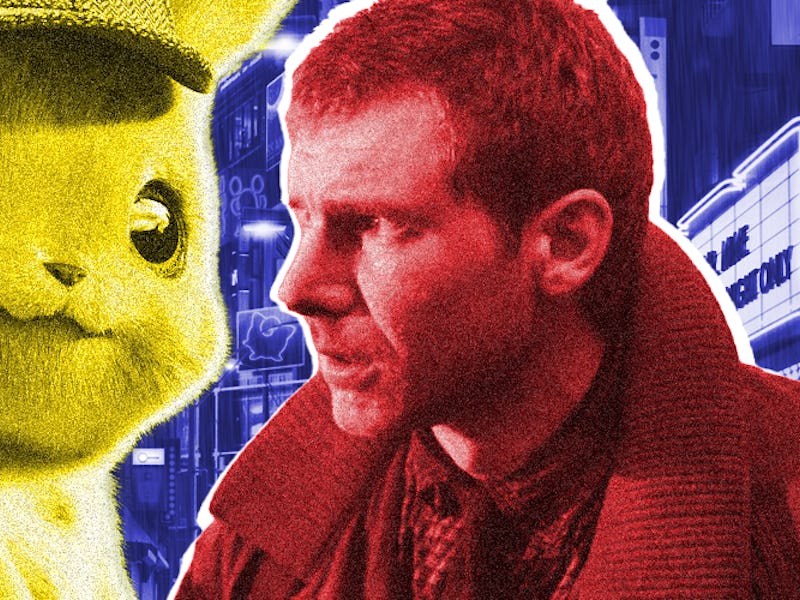‘Detective Pikachu’ Drew Its Unique Style From an Unlikely Neo-Noir Classic
“It was the first time I saw a science fiction movie that felt real and tactile," director Rob Letterman tell Inverse.

Detective Pikachu isn’t just another video game movie. Strip away the millennial fan service and PG-rated humor, and there’s a gritty noir detective story underneath that just happens to star Ryan Reynolds as the voice of a talking electric mouse in a Sherlock Holmes hat. To pull off this unlikely mix of styles, director Rob Letterman turned to another classic film that mashed together unexpected genres to make something great.
“We try to do a sort of daytime [Blade Runner]((https://www.inverse.com/article/36624-blade-runner-2049-secret-character-sean-young-rachael-replicant) vibe,” Letterman tells Inverse, referencing the 1982 Ridley Scott movie starring Harrison Ford as a robot bounty hunter.
Letterman, who grew up watching (and rewatching) Blade Runner, credits the movie with pioneering a “neo-noir vibe” that mixed black-and-white detective movies with Japanese influences.
“It was the first time I saw a science fiction movie that felt real and tactile and so beautiful,” he says.
Almost four decades later, Letterman used Blade Runner as a reference for Detective Pikachu. It may seem like a strange pairing, but when you view the two movies side-by-side, the influence is clear.
“We worked really hard to make the CGI as natural and organic as possible.”
Blade Runner follows Deckard (Ford) as he tracks a group of advanced robots, called replicants, through a dystopian Los Angeles in the year 2019 (yes, 2019). Along the way, Deckard falls in love with a female replicant named Rachael, and by the end of the movie it’s unclear whether he’s a robot himself.
Detective Pikachu doesn’t follow that formula exactly. The setting, Ryme City, might look like a mix of London, New York, and Tokyo, but it’s full of friendly Pokémon — not killer robots. Where the new movie does borrow from Blade Runner is in its visual language: shadowy rooms, cramped alleyways draped with hanging wires, and gleaming towers imposing themselves over the city.
To pull this off, Letterman “chased down” John Mathieson, a cinematographer whose credits include the Ridley Scott movies Gladiator and Kingdom of Heaven (but not Blade Runner), and now, Detective Pikachu.
“Jon was familiar with Blade Runner” Letterman says. “It just came up a lot.”
“If the artistry is there, things hold up.”
Beyond the visual style and its neo-noir undertones, Detective Pikachu also borrows from Blade Runner and other early sci-fi movies like 2001: A Space Odyssey by relying on as little computer-generated imagery as possible — not easy for a movie full of digitally created video game creatures.
“We worked really hard to make the CGI as natural and organic as possible,” Letterman says.
That means shooting on film (not digitally) and working on location. Ryan Reynolds was also on set for multiple scenes, speaking his lines from behind the camera while the movie’s human lead (played by Justice Smith) made eye contact with a puppet or a tennis ball on a stick.
“We used almost no green screen in the movie,” Letterman says. “We let it be imperfect and gritty and loose.”
As a result, the director hopes that a decade from now his movie will still hold up even as CGI technology advances far beyond what it’s capable today.
“If the artistry is there, things hold up,” he says. “It’s just the nature of filmmaking. 2001: A Space Odyssey still looks better than most things CGI.”
"We try to do a sort of daytime 'Blade Runner' vibe."
Back in 1982, Blade Runner opened to mixed reviews. Roger Ebert called it “a stunningly interesting visual achievement, but a failure as a story,” arguing that Scott cared more about the futuristic world he was creating than the actual characters living in it or they story he was telling.
Here’s how Ebert wrote about the movie’s lush dystopia:
We don’t just get the skyways and the monolithic skyscrapers and the sky-taxis, we also get notions about how restaurants, clothes and home furnishing will look in 2020 (not too different). Blade Runner is worth attending just to witness this artistry.
Similarly, Detective Pikachu does an impressive job of creating its three-dimensional world. What’s a coffee shop like in a city populated with Pokémon? How about a street food market? Or a seedy underground club? Packed into a decent noir story, there’s a fascinating universe rendered in beautiful purple shadows, neon reds, and yellow bolts of electricity.
“It was the first time I saw a science fiction movie that felt real and tactile and so beautiful.”
Despite its rocky start, Blade Runner went on to achieve cult classic status, inspire a generation of filmmakers, and even spawn a sequel 35 years later. With any luck, Detective Pikachu will be just as relevant three-and-a-half decades from now — assuming the CGI holds up as well as Rob Letterman hopes it will.
Detective Pikachu hits theaters on May 10.